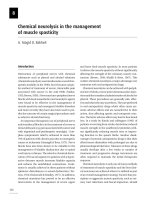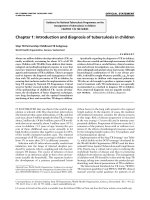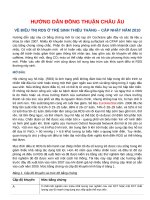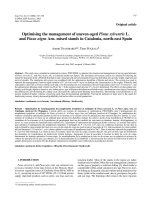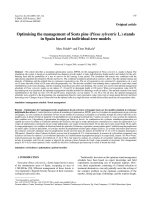Studies on the management of maize weevil (sitophilus zeamais l ) using botanicals on maize grain in storage
Bạn đang xem bản rút gọn của tài liệu. Xem và tải ngay bản đầy đủ của tài liệu tại đây (1.73 MB, 93 trang )
ADDIS ABABA UNIVERSITY
COLLEGE OF NATURAL AND COMPUTATIONAL SCIENCES
GRADUATE PROGRAM
Studies on the management of maize weevil (Sitophilus zeamais L.) using
Botanicals on maize grain in storage
BY
YESHIWORK ALEMNEW
A Thesis submitted to the Department of Zoological Science of Addis Ababa University in Partial
fulfillment of the Requirements for the Degree of Master of Science in Entomology (Insect science).
JUNE, 2017
DECLARATION
I, the under signed, declare that this thesis is my original work. It has never been submitted to any
institution and that all sources of materials used for the thesis have been acknowledged.
Name: Yeshiwork Alemnew
Signature ___________________
Date ___________________
This thesis has been submitted for examination with my approval as
Advisor: Emana Getu (PhD) (Professor)
Signature __________________
Date __________________
ii
ACKNOWLEDGMENTS
First and foremost I would like to glorify and bring the greatest of all thanks to GOD for the
strength he has given me to withstand all burdens and rigorous to complete this work.
I wish to express my most sincere appreciation and gratitude to my advisor Prof. Emana Getu
as without his valuable comments, unreserved guidance and professional expertise the
completion of this work would not have been realized.
I express my deepest appreciation and special thanks to Kombolcha Plant Health Clinic
Laboratory staffs for their technical and material supports to conduct this work. I also
appreciate the plant health clinic support staff for their collaboration during my study period.
The support of many good people, colleagues and friends who devoted their time and resources
to assist me during my study period is greatly acknowledged. Without their kind help this study
would have been hardly possible. My special thanks go to Mr. Beyene Mamo of Wollo
University for his support during identification, collection and preparation of botanicals and
other moral and technical supports. I also wish to mention my sense of gratitude to Agegn
Shibeshi for his kind and sincere support. Encouragements and morals from my family are
dully acknowledged.
I sincerely also like to thank Wollo University for the sponsorship it provided to me to pursue
my post-graduate studies and also thanks Addis Ababa university for accepting me as M.Sc
student. The zoological sciences department and insect sciences stream provided me with the
necessary supports. Many thanks to both.
My special appreciation also goes to Dr. Tewodros Mulugeta for his support I needed in data
analyses.
iii
LIST OF ABBREVIATIONS
AAU
Addis Ababa University
BARC
Bako Agricultural Research Center
CRD
Completely Randomized Design
CPSE
Crop Protection Society of Ethiopia
CSA
Central Statistical Authority
EARO
Ethiopian Agricultural Research Organization
EIAR
Ethiopian Institute of Agricultural Research
IITA
International Institute of Tropical Agriculture
IPM
Integrated pest management
K-PHC
Kombolch Plant Health Clinic
MARC
Melkassa Agricultural Research Center
NSIA
National Seed Industry Agency
PMJOE
Pest Management Journal of Ethiopia
HSD
High Significant difference
SAS
Statistical Analysis System
SNNP
Southern Nations, Nationalities Peoples regional state
w/w
weight by weight
iv
Table of Contents
DECLARATION ......................................................................................................... ii
ACKNOWLEDGMENTS .......................................................................................... iii
LIST OF ABBREVIATIONS ..................................................................................... iv
TABLE OF CONTENTS ---------------------------------------------------------------------v
LIST OF TABLES ..................................................................................................... vii
LIST OF FIGURES .................................................................................................. viii
LIST OF ANNEXES .................................................................................................. ix
ABSTRACT ................................................................................................................. x
1. INTRODUCTION ................................................................................................. 1
1.1 Objectives of the Study ............................................................................................... 4
1.1.1 General objective ................................................................................................. 4
1.1.2 Specific objectives ............................................................................................... 4
2. LITERATURE REVIEW ...................................................................................... 5
2.1
Production and Productivity of Maize .................................................................................5
2.2.
Major post harvest insect pests of stored maize grain ..........................................................7
2.3.
Post harvest losses due to S.zeamais ....................................................................................8
2.4.
Biology and description of S.zeamais ..................................................................................9
2.5.
Management Practices of S.zeamais ..................................................................................12
2.5.1 Cultural practices ............................................................................................. 13
2.5.2 Physical control ............................................................................................... 14
2.5.3.Varietal resistance ............................................................................................ 15
2.5.4 Biological control ............................................................................................. 17
2.5.5 Botanical control .............................................................................................. 18
v
2.5.6 Chemical control .............................................................................................. 23
2.5.7 Integrated Pest Management------------------------------------------------------------24
3. MATERIALS AND METHODS ........................................................................... 25
3.1 Description of the Study site ...................................................................................................25
3.2. Experimental design ...............................................................................................................25
3.3 Collection and preparation of Plant materials ........................................................................25
3.4 Establishment of maize weevil culture ...................................................................... 26
3.5 Application of Botanicals for the Control of S.zeamais .........................................................28
3.6 Data Collection.......................................................................................................................28
3.7 Data Analysis--------------------------------------------------------------------------------------- ---31
4. RESULTS .............................................................................................................. 33
4.1. Effect of botanicals on parent adult weevil mortality ............................................................33
4.2. Effect of botanicals on emergence of F1 progeny..................................................................42
4.3. Effect of botanicals on protection of grain from F1 progeny .................................................42
4.4. Evaluation of Percent Weight loss .........................................................................................45
4.5. Evaluation of Percent seed damage ........................................................................................45
4.6. Effect of botanicals on germination of seeds .........................................................................48
5. DISCUSSION ........................................................................................................ 49
6. CONCLUSION ...................................................................................................... 57
7. RECOMMENDATION ......................................................................................... 58
8. REFERENCE ......................................................................................................... 59
vi
LIST OF TABLES
PAGES
Table 1: List of botanical powders and insecticide tested against S.zeamais .................................... 27
vii
LIST OF FIGURES
PAGE
Figure 1: Life cycles of S. zeamais ................................................................................................... 12
Figure 2: Mean percent adult mortality of S.zeamais on maize grains treated with different botanical
powders one day after treatment application. .................................................................................... 34
Figure 3: Mean cumulative percent adult mortality of S.zeamais on maize grains treated with
different botanical powders five days after treatment application. .................................................... 35
Figure 4: Mean cumulative percent adult mortality of S.zeamais on maize grains treated with
different botanical powders ten days after treatment application. ..................................................... 37
Figure 5: Mean cumulative percent adult mortality of S.zeamais on maize grains treated with
different botanical powders fifteenth days after treatment application. ............................................ 38
Figure 6: Mean cumulative percent adult mortality of S.zeamais on maize grains treated with
different botanical powders twenty one days after treatment application. ........................................ 40
Figure 7: Mean cumulative percent adult mortality of S.zeamais on maize grains treated with
different botanical powders twenty eight days after treatment application. ...................................... 41
Figure 8: F1 progeny emergency of S.zeamais from maize grain treated with different botanical
powders. ............................................................................................................................................. 43
Figure 9: Effect of botanicals on mean percent protection of maize grain from F1progeny ............. 44
Figure 10: Effect of botanicals on mean percent weight loss of maize grains treated with different
botanical powders .............................................................................................................................. 46
Figure 11: Effect of botanicals on mean percent seed damaged of maize grains treated with different
botanical powders ............................................................................................................................. 47
Figure 12: Mean percent germination of maize grains treated with different botanical powders ..... 48
viii
LIST OF ANNEXES
PAGES
ANNEX 1: Sample pictures taken during the experiment -------------------------------------------------78
ANNEX 2: Six-months mean monthly temperature and relative humidity of the laboratory
at K-PHC (2009) _____________________________________________________________79
ix
ABSTRACT
The production and storage of maize are threatened by a wide range of pre-and post harvest pests
like stalk borer, Angoumois grain moth (Sitotroga cerealella Olivier), and Sitophilus spp among
others. The current experiment was conducted to determine the efficacy of leaf and seed powder of
four botanical plants (Azadirachta indica Juss, Lantana camara L., Jatropha curcas L., Croton
macrostachys Hochst) at four concentrations against maize weevil (Sitophilus zeamais Motsch.) on
stored maize grains under laboratory conditions. For comparison, malathion 5% dust as a standard
check and untreated check were used. The experiment was designed in a completely randomized
design in three replications. The experiment was conducted under room temperature of 250c‒280c
and relative humidity of 68.5% ‒74.5 % at Kombolcha Plant Health Clinic Laboratory. Powders of
each plant component were then mixed thoroughly with 200 gram grains in plastic jars roofed with
muslin cloth and tightened with rubber band. Thirty adult weevils were released in each plastic jar.
Number of dead weevils, F1 progeny, percent protection from F1 progeny, weight loss, and
damaged seed and number of germinated seed were recorded after treatment application. Data were
transformed prior to analyses. Transformed data were subjected to ANOVA in SAS software. All
botanical powder significantly resulted in weevil mortality, F1 progeny reduction, low seed damage
and weight loss. The botanical powders did not affect the germination capacity of maize seed.
J.curcas seed powder and A. indica seed powder were highly significant than the rest of the
treatments which was comparable with malathion 5% dust (P <0.05) in all of the parameters, while
L. camara and C. macrostachyus was the least effective compared to the botanicals and the
standard check, but significantly (p<0.05) better than the untreated check (P <0.05). In general, J.
curcas seed powder and A. indica seed powder found to be the most effective treatment against
maize weevil on stored maize grain. However, further investigation of those plant powders under
real storage conditions and their long term (chronic) toxicity on mammals and beneficial organisms
are needed. Consequently, the current result should reach the stakeholders mainly farmers through
extension agents.
Key words: Botanicals, S.zeamais, Rates, Maize, untreated check.
x
xi
1. INTRODUCTION
Maize (Zea mays L.) is the third important cereal crop globally after wheat and rice (FAO, 2011).
Maize is a member of the grass family, Poaceae (Gramineae). Maize is one of the most important
cereal crops cultivated in the world and it constitutes one of the major diets of millions of people.
In Africa, maize is mainly grown by small-scale farmers for utilization as both human food and
animal feed. Maize is the staple food and one of the main sources of calories in the major
producing regions (Kebede Mulatu et al., 1993).
The recent volatile food market and rising prices for most food crops may increase the
importance of maize production. In addition, because of its productivity and wide adaptation,
maize remains an important source of food with great potential to improve the livelihoods of
most poor famers in developing countries (FAO, 2011). But, its productivity is low due to
several constraints: biotic (inadequate improved varieties, pests and diseases), a biotic (low soil
fertility, land and water degradation, and drought) and socio-economic (input unavailability, lack
of storage facility, poor access to markets) (CSA, 2010).
Maize is also becoming one of the export crops of Ethiopia generating foreign currency for the
nation (EARO, 2000). In addition, maize provides nutrients for humans and animals and serving
as a basic raw material for the production of starch, oil and protein, alcoholic beverages, food
sweeteners and more recently, fuel (FAO, 1992). The crop is mainly grown for its grain, which is
utilized for human consumption and forms about 50 - 70% of the constituent of livestock feed
(Longe, 2010).
Maize can be processed into various food and industrial products including starches, sweeteners,
oil, beverages, industrial alcohol and fuel ethanol. Likewise, thousands of foods and other
everyday items such as toothpaste, cosmetics, adhesives, shoe polish, ceramics, explosives,
1
construction materials, metal molds, paints, paper goods clothing, packaging, carpeting,
recreational equipment and food utensils of renewable resource and textiles contain corn
components. In addition, maize products are rapidly replacing petroleum in many industries in
the world (Ogunsina et al., 2011).
It is an important source of protein ranking 4th after meat, fish and legumes in term of annual
protein production (Dasbak et al., 2008). The green plant, made into silage, has been used with
much success in the dairy and beef industries. Worldwide, about 66% of maize is used for
feeding livestock, 25% for human consumption and 9% for industrial purposes. In the
developing world, about 50% of all maize is consumed by humans as food, while 43% is fed to
livestock and the remainder for industrial purposes (IITA, 2003).
Maize weevil (Sitophilus zeamais Motsch) is a major pest that attack stored maize grains in the
tropics and sub-tropics of the world (Adedire, 2001; Sagheer et al., 2013). The attack may start in
the mature crop when the moisture content of the grain had fallen to 18-20% (Radha, 2014).
Subsequent infestations in store result from the transfer of infested grain into store or from the
pest flying into storage facilities, probably attracted by the odor of the stored grain.
Post-harvest losses of food grains due to insect pests pose significant nutritional and economic
losses to subsistence farmers in developing countries’. Lack of improved storage structures for
grains and absence of storage management technologies force maize growers to sell their
produce immediately after harvest. Consequently, farmers receive lower market price for the
surplus grain they produced (Firdisa Eticha and Abraham Tadesse, 1999). In view of the great
value of maize, it is imperative, that greater attention should be given to the crops during storage
in order to make them available for use throughout the year (Longe, 2010).
2
In order to reduce serious losses experienced during storage, various techniques and control
methods have been developed and more are still being developed. The destructive activities of
insects and other storage pests have been adequately subdued by synthetic chemical control
methods comprising fumigation of stored commodity with carbon disulphide, phosphine or
dusting with malathion, carbaryl, pirimiphosmethyl or permethrin (Ileke and Oni, 2011).
However, there are problems associated with the use of these synthetic chemicals.
The problems of many synthetic insecticides include high persistence, poor knowledge of
application, increasing costs of application, pest resurgence, genetic resistance by the insect and
lethal effects on non-target organisms in addition to direct toxicity to users (Akinkurolele et al.,
2006; Oni and Ileke, 2008).Currently, attention is being given to the use of plant materials with
medicinal properties as grain protectants (Longe, 2010). Most of them are non toxic to
consumers and are readily available (Asawalan et al., 2006).
Plant-derived insecticides are short-lived in the environment, thus posing less risk to non-target
organisms and are accepted by organic certification programs and certain consumer groups
because they are naturally occurring (Isman, 2000). These are less cost effective for storage of
large quantities of grain. Many farmers are interested in learning about non-chemical pest
control, either because they have had insufficient money for pesticides, or because they are
interested in farming more organically, so farmers in Ethiopia use different botanical plants to
protect their maize grain from insect infestation (Abraham Tadesse, 1997), while the type of
botanical plants used varies from locality to locality.
However, the efficacy of these botanicals is not known except for few. In addition to this most
farmers are ignorant of the correct rate and parts of the botanicals and amount of botanicals that
3
could be toxic to storage pests for effective pest control. This has led to investigate the
insecticidal activities of various botanical plants at various rates using seed and leaf of the
plants.
1.1 Objectives of the Study
1.1.1 General objective
To investigate environmentally safe and economically feasible management of S. zeamais
through the use of appropriate rate of locally available plant powders.
1.1.2 Specific objectives
1.
To determine the efficacy of different locally available botanicals on maize grain in storage.
2.
To determine the rate of botanicals at which they could be applied to stored grains in order to
effectively control S. zeamais.
3.
To know which part of the plant (the seed or the leaf powder) is more effective against the
maize weevil (S. zeamais).
4
2. LITERATURE REVIEW
2.1 Production and Productivity of Maize
Maize is the most important cereal and cash crop in sub-Saharan Africa and is part of the staple
diet for over 1.2 billion people in developing countries. Under certain circumstance maize is used
to generate cash for farmers (IITA, 2016). The center of origin is believed to be the Mesoamerica
region, at least 7000 years ago when it was grown as a wild grass called teosinte in the Mexican
highlands. Maize is one of the most versatile emerging crops having wider adaptability under
varied agro-climatic conditions. Maize together with wheat and rice are the three most cultivated
cereal crops worldwide (Suleiman et al., 2013).
Current world maize production is about 10.14 billion metric tons (De Groote et al., 2013). The
United States of America is the largest producer of maize which contributes nearly 35 % of the
total production in the world. The word maize means “one that sustains life” and also an Indian
legend says that maize was the food of the Gods that created the earth.
The area under maize cultivation is the highest in United States, China, Brazil, Mexico and India.
These countries contribute about 4/5th of the world’s total maize production. The production of
maize is constantly increasing because of the rising demand from the industries since maize is
used as raw material. Globally, India ranks 5th in area and 4th in production (Pal et al., 2009). It
is notable that eight major maize producing countries in Asia, China, India, Indonesia, Nepal,
Pakistan, Philippines, Thailand and Vietnam taken together, now produce 98 per cent of Asia’s
maize and 26 per cent of global maize (Erenstein, 2010). In all these countries, maize is
predominantly grown under rain fed conditions by the small holders, resource-poor farmers.
5
Hence, maize plays an important role in the livelihood of poor farmers, not only in Latin America
and sub-Saharan Africa, but also in Asia (Prasanna, 2011). Because of its productivity and wide
adaptation, maize remains an important source of food with great potential to improve the
livelihoods of most poor famers in developing countries (FAO, 2011).
Current maize production in sub-Saharan Africa is about 7 million metric tons (FAO, 2014).
Maize is known to Ethiopia since the last 500 years. It was introduced in between 1600s to 1700s.
Ethiopia, one of the world’s centers of genetic diversity in crop germplasm (McCann, 2001),
produces more of maize than any other crop (CSA, 2010). Ethiopia is the fifth largest producer of
maize in Africa and smallholder farmers make up 94 % of the crop production. It is the cheapest
source of caloric intake in Ethiopia, providing 16.7 % of per capita calorie intake nationally
followed by sorghum (14 percent) and teff (11 percent). Maize is an important crop for overall
food security. Maize is grown primarily in the Amhara, Oromia and SNNP regions of Ethiopia.
Maize is widely grown in all parts of Ethiopia. An area of 1.4 million hectares of land is covered
with maize and the annual maize production is not less than 2.52 million tons (NSIA, 2001).
Maize productivity (1.98 tons ha-1) is leading all cereals in the country (CSA, 2000), but
compared to the world’s average production (3.7 tons ha-1) and to that of developing countries
(2.5 tons ha-1) is still low.
The largest quantity (95%) of maize is produced by small-scale farmers in Ethiopia. Surplus
production comes from the southern, south western, western and eastern parts of Ethiopia (Mulatu
Kebede et al., 1993). The major production zone of maize lays between 1000 m to 2000 m asl.
Maize was also number one in yield per hectare and total production in the mid-altitude, subhumid areas of Western Ethiopia (CSA, 2011).
6
2.2 Major post harvest insect pests of maize in storage
Among the major constraints of maize production and productivity in tropical countries including
Ethiopia are the damage caused by insect pests both in the field and storage. Maize is attacked by
many insect pests during all stages of growth from seedling to storage (Shiferaw et al., 2011).
Insects and other pests are a major threat to maize production and responsible for direct and
indirect losses of maize on the farm and storage (Bankole and Mabekoje, 2004). According to
Mihale et al. (2009) insects are responsible for 15-100 % and 10-60 % of the pre and post-harvest
losses of grains in developing countries, respectively.
Two major groups of insects are economically important on stored maize grain: Coleoptera
(beetles) and Lepidoptera (moths and butterflies). Crop damage by Lepidoptera is only done by
the larvae. In the case of Coleoptera, both larvae and adults often feed on the crop and the two
stages are responsible for the damage. Post-harvest insect pests may be primary, i.e. are those
which damage previously undamaged seed such as the genus Sitophilus, while secondary pests
are those which cannot damage sound seed but attack seeds which are already damaged either
mechanically or by primary pests such as the genus Sitophilus. The most important insect pests
that cause damage to maize are stalk borers (in the field) and weevils and moths (in the storage)
(Emana Getu and Tsedeke Abate, 1999). Crop losses and deterioration of produce during storage
are likely to occur unless adequate precautions are taken (Araya G/silassie, 2007)
The major insect pests of stored maize grains include maize weevil (Sitophilus zeamais Motsch.),
the Angoumois grain moth (Sitotroga cerealella Olivier), the tropical warehouse moth (Ephestia
cautella Hubner), the Indian meal moth (Plodia interpunctella Hubner), flour beetle (Tribolium
spp.), Cryptolestes spp and Carpophilus spp. (Abraham Tadesse, 2003).
7
According to Obeng-Ofori and Amiteye (2005), S. zeamais is a serious cosmopolitan field-tostore pest of maize in tropical and subtropical regions. S.cerealella is also the most important
primary pest of maize in the field and storage. The curculionids, S. zeamais and S. oryzae and the
Gelechid, S. cerealella are the most destructive primary pests of stored grain in Ethiopia
(Abraham Tadesse, 2003).
2.3 Post harvest losses due to S. zeamais
Maize storage is constrained by a number of factors which include attack from pathogens and
insect pests. Insect pests are the major threat destroying approximately 20% to 50% of stored
maize grain in most African countries (CABI, 2012). In many developing countries, overall post
harvest losses of grain of about 10% to15% are fairly common. Insect pest damage in stored food
grains may account for 10% to 40% in countries where modern storage technologies have not
been introduced. One of the main problems in storage in developing countries is management of
the store and a continuous source of infestation in the stored area. Farmers in most areas keep old
and new harvest grain in the same vicinity, which causes an easy migration or infestation of new
grains from the old grains which is known as cross infestation (Adugna Haile, 2006).
Among insect pests, the maize weevil, S. zeamais is reported to cause high grain loss in stored
maize. The maize weevil is a major pest of stored maize grains and its infestation causes severe
post harvest losses of staple food crops in Nigeria (Oni and Ileke, 2008). Weevil damage reduces
the availability of maize and may also reduce future maize production for farmers who use stored
grains. In developing countries, maize production and consumption often falls below demand as a
result of post-harvest losses due to storage pests and other spoilage agents (Udo, 2005). In stored
8
maize, heavy infestation of this pest may cause weight losses of 30% to 40% (Ogunsina et al.,
2011; Radha, 2014). Like many other crops, insect pests are one of the limiting factors during
storage of maize in Ethiopia. The problem is mostly severe in developing countries in the tropics
due to unfavorable climatic conditions and poor storage structures (Bekele Jembere et al., 1997).
Insect infestation of maize grains leads to a reduction in both quality and quantity of harvested
crops and in most cases pre-disposes the stored grains to secondary attack by disease causing
pathogens. Post-harvest losses due to S. zeamais have been recognized as an important constraint
to grain storage in Africa (Oduor et al., 2000).
The maize weevil is one of the most destructive stored product pests of grains, cereals, and other
processed and unprocessed stored products in sub-Saharan Africa (Ojo and Omoloye 2012). S.
zeamais causes qualitative and quantitative damage to stored products, with grain weight loss
ranging between 20% to 90% for untreated stored maize grain (Muzemu et al., 2013). Damaged
grain has reduced nutritional value, low percentage germination, reduced weight and lowered
market value (Girma Demissie et al., 2008).
2.4 Biology and description of S. zeamais
Knowledge of the biology of the insect pests is paramount importance in any control or pest
management strategy. There cannot be a realistic success in management without a better
understanding of the phenology and dynamics of insects’ life cycle (Merville et al., 2014).Adult
maize weevils are 3–3.5 mm long, dark brown to black in color and shiny and pitted with
numerous punctures. The punctures on the thorax are in an irregular pattern, while those on the
elytra (wing cases) are in lines.
9
A newly emerged weevil is light brown to reddish-brown. It is easily identified by the presence of
four light reddish or yellowish pale spots on the elytra (Khare, 1994). The maize weevil has the
characteristic rostrum (snout or beak). At the end of this structure, there is a pair of mandibles or
jaws and elbowed antennae of the family Curculionidae. The antennae have eight segments and
are often carried in an extended position when the insect is walking.
The maize weevil, although similar to rice weevil is somewhat bigger in size than the rice weevil.
Adult maize weevils are slightly larger than rice weevils. They have circular punctures on the
thorax compared to oval punctures on the rice weevil and more distinct colored spots on the
forewings. Maize weevils are strong fliers than rice weevils. Rice weevil is found more often on
small grains and has a higher temperature tolerance than maize weevil. Both species fly and thus
attack cereals in the field before harvest, but flight activity is more pronounced in maize weevil.
Harney (1993) demonstrated that maize weevil differs from rice weevil mainly with respect to
genital character.
The origin of maize weevil is not known, but now it is found in all warm and tropical parts of the
world (Dicko et al., 2006). Maize weevil is widely distributed throughout the warm humid areas
of the world and can attack a wide range of cereals although it is particularly a pest of maize
(Ranjan, 2005). It is well established in tropical countries including Ethiopia. Maize weevil and
rice weevil are found in all warm and tropical parts of the world. These pests are carried all over
the world in grain shipments and can establish themselves wherever there is food and where grain
moisture and temperature are favorable. In various locations, one species may be more common
than the other. The female weevil chews a minute hole in the grain in which the eggs are
deposited.
10
Eggs are deposited singly in narrow cavities chewed in the kernels and the hole is sealed with a
mucilaginous material secreted by the female (Hill, 2008). The eggs are white and oval in shape,
measuring 0.7 mm by 0.3 mm, and each female may deposit as many as five eggs per day laying a
total of 150 to 400 eggs during its life span (Bosque-Perez, 1992). The eggs hatch into tiny grubs
in four to nine days. Larval development last about 25 days under favorable conditions of
o
temperature of 30 C and 70% relative humidity, but under unfavorable environmental conditions,
the larval stage may last for up to 98 days (Mattah, 2001). The grub is white in color with a brown
head and strong jaws. Pupation occurs within the grain, and the pupal stage lasts for three to six
days. The newly emerged adult remains in the grain for a few days before it leaves it (Chilio et
al., 2004)
Eggs, larval and pupal stages are all found within tunnels and chambers bored in the grain and are
not seen. Because larval stages feed in the internal parts of the grain, it is difficult to detect
infestations early. Damage caused by this insect becomes noticeable when the adult insect makes
holes that reach approximately 1mm in size in the grain and deposits its eggs within the hole. The
insect then closes up the developmental stage of the insect takes place within the grain after which
the adult weevil bores its way out, leaving a characteristic emergence hole on the grain. Adults
emerge from the grain and can be seen walking over the grain surfaces. The life span (from egg to
adult) is about 30 days, which is slightly longer than that of rice weevil. Mating takes place within
a few hours after the adult weevils emerge (Abraham Tadesse, 1991).
Abraham Tadesse (1991) and Abraham Tadesse et al. (1996) studied the biology of the maize
weevil at room temperature and relative humidity conditions at Bako. He found that a female
maize weevil remained fecund throughout its lifetime; however, the actual time of oviposition
11
was about 50% of the mean life span of the ovipositing female. The duration of the life cycle
varies with temperature, relative humidity and diet (Abraham Tadesse, 1991). Abraham Tadesse
(1991) reported that the mean time required for adult emergence around Bako areas ranged from
35.7_47.4 days, and females lived longer than males. The sex ratio is about 1:1 and up to four
weevils can emerge from a single kernel. Adult maize weevil is an active flier resulting in many
field infestations in areas adjacent to infested storage.
Figure 1: Life cycles of S. zeamais
12
2.5 Management Practices of S. zeamais
Most of the maize grain harvested was stored on the farm where postharvest pest management
practices are inadequate (Dubale, 2011) leading to huge amounts of maize grain losses to pests of
stored grain. Maize weevil populations build up when maize grain is kept longer in the store. So it
is important to inspect the stock regularly. If the pest is found beyond certain population level
some form of control is being required.
2.5.1 Cultural practices
Initial infestation by maize weevil occurs in the field. From the field, it is carried over to the store
where the population can rapidly build up. Field infestations may result from insects migrating
from infested seeds in adjacent granaries to the ripening crop. Thus, pre-harvest cultural methods
and storage management can be effective in the control of pests affecting stored grain. Field
isolation; prompt harvesting, selection of uninfected grain, proper drying before storage and
storage hygiene among others are important cultural practices reported for the management of
storage pests (Abraham Tadesse and Firdissa Eticha, 2000).Repairing and thorough cleaning of
storage containers before filling with grain alone kept the grain for longer time in the traditional
(well built and well managed) experimental stores at Melkassa (Abraham Tadesse, 2003).
The severity of maize weevil infestation can be reduced by good store hygiene: cleaning the store
between harvests, removing and burning infested residues, fumigating the store to eliminate
residual infestations and the selection of only uninfected material for storage. Harvesting maize as
soon as possible after it has reached physiological maturity will reduce weevil damage, reduces
the availability of maize and may also reduce future maize production for farmers who use stored
grains as seeds.
13
In developing countries, maize production and consumption often falls below demand as a
result of post-harvest losses due to storage pests and other spoilage agents (Udo, 2005).
2.5.2 Physical control
Physical methods are important means to prevent, detect and control stored product pest within
the concept of Integrated Pest Management (IPM) and Integrated Stored Product Protection.
Physical control refers to non-chemical, non-biological methods that destroy pests or make the
environment unsuitable for the entry or survival of pests. The removal of adult insects from the
grain by sieving can reduce populations but this is very labour-intensive. If one thinks of staple
food such as grains or pulses, cleaning, drying, and cooling are physical processes essential to
keep a durable product in good quality during prolonged storage periods (Vincent et al., 2003).
Physical control methods can be simple, affordable, and safe methods of controlling stored insect
pests in grain facilities. Physical control methods have been described as effective and alternative
methods to pesticides to prevent and control pests during grain handling and storage.
(Jayaprakash et al., 2010).
Studies on physical methods of pest managements generally involved heat treatment and testing
the effectiveness of solar radiation, although few studies also evaluated the role of oven heating.
Another method that has gained importance in industrialized countries in recent years is the heat
treatment of empty structures (Beckett et al., 2007).The high temperatures needed for pest control
can be achieved by burning oil or gas and fanning the heated air into a building from outside
through air ducts. Another method is the recirculation of air within a building and heating with
mobile electrical heaters (Hofmeir, 2000).
14
